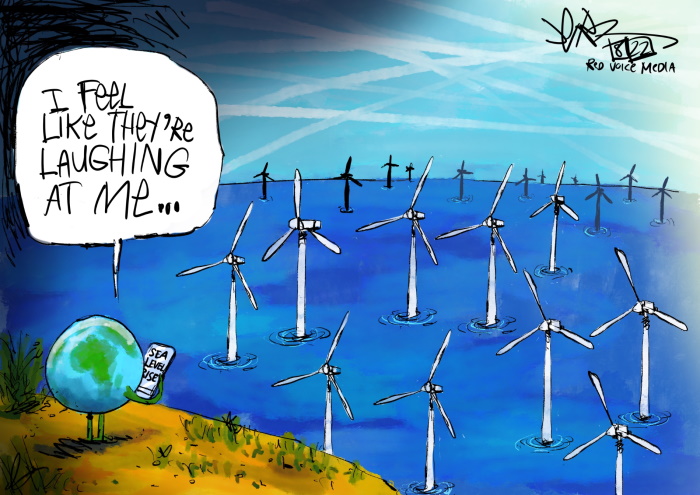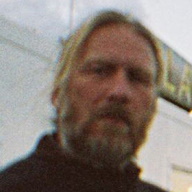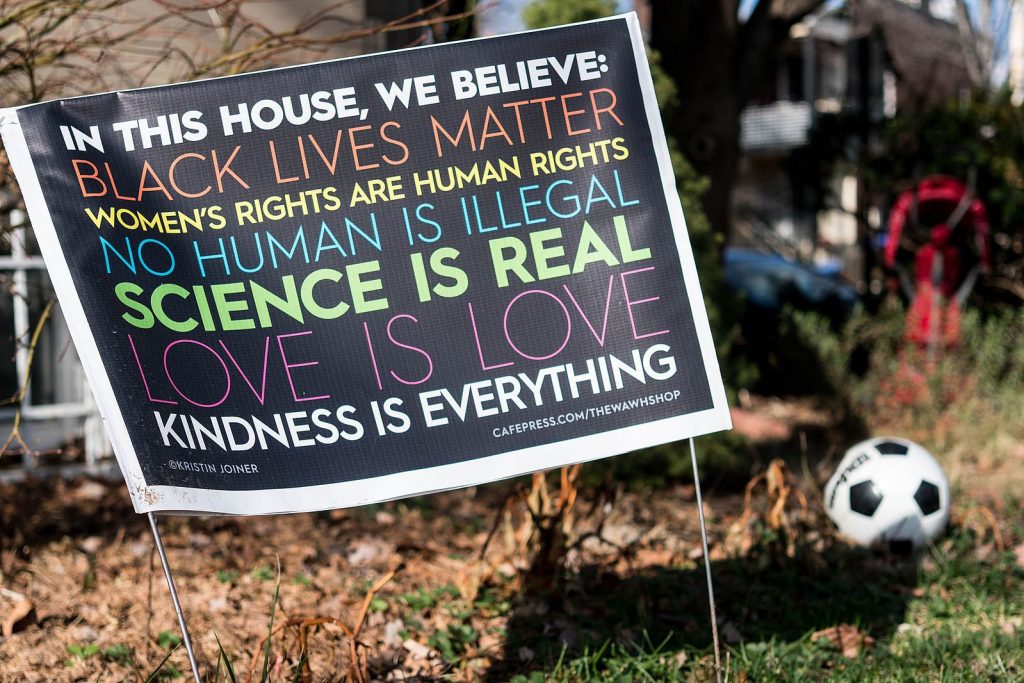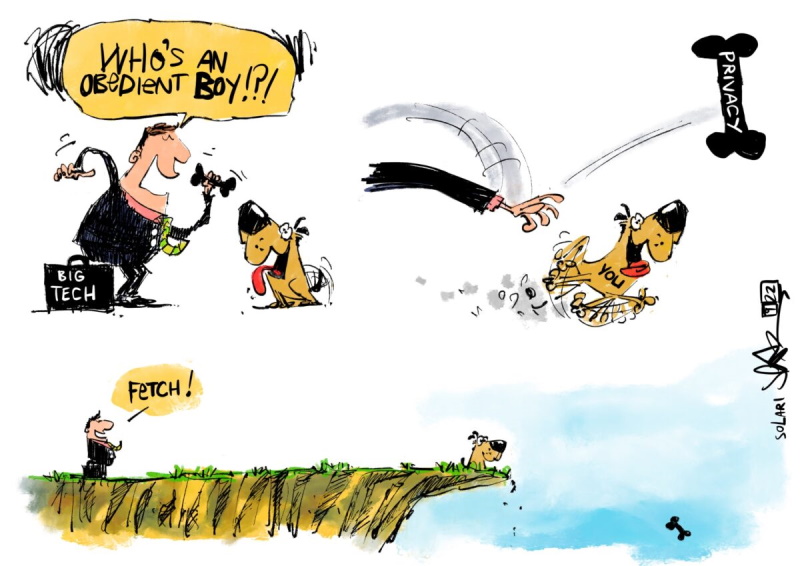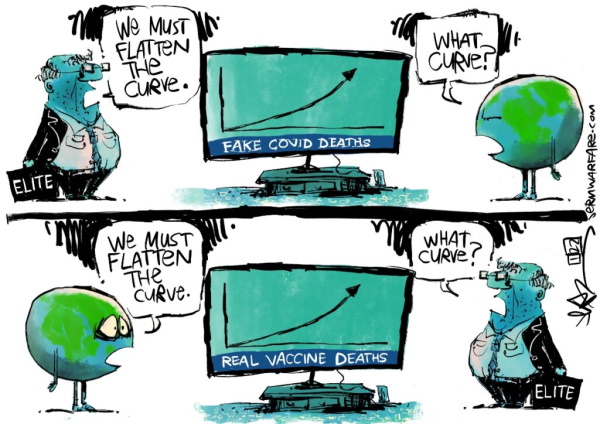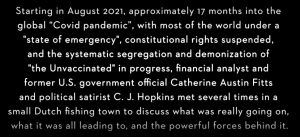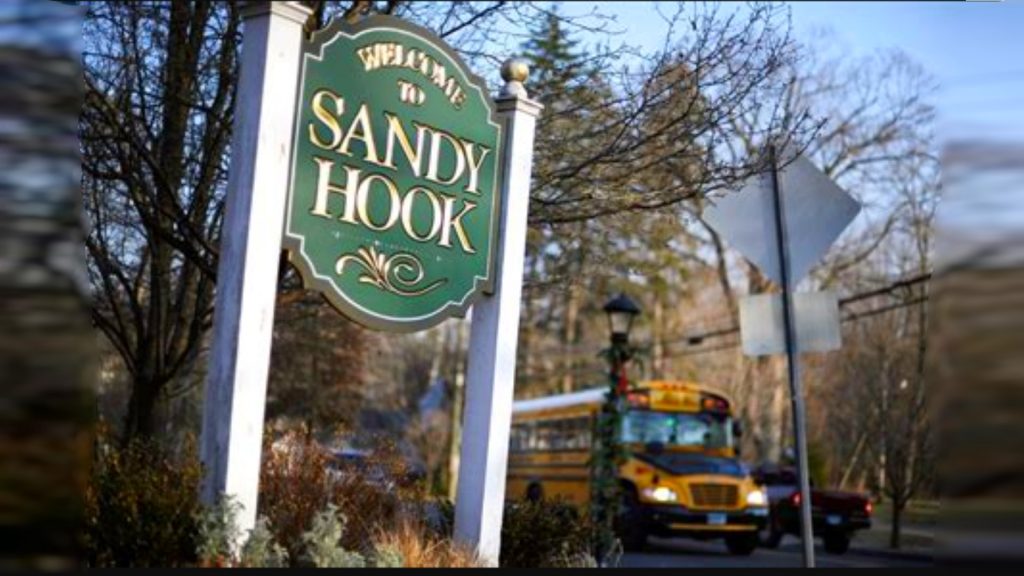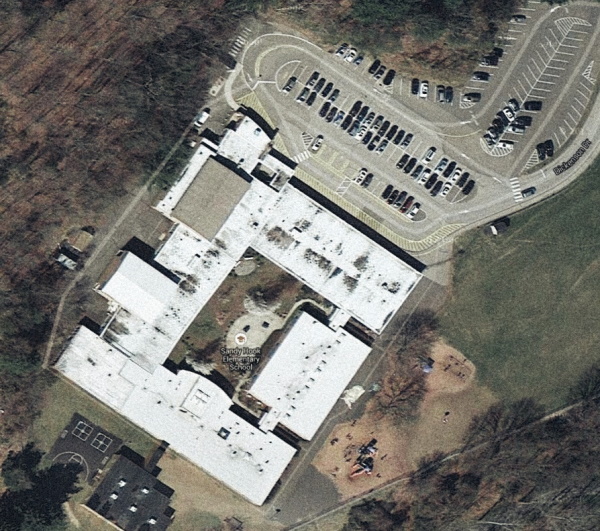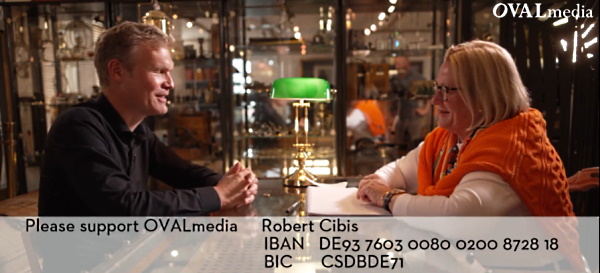What You Need to Know About Wireless Technology
by Arthur Firstenberg, Cellular Phone Task Force
first published September 2001, revised August 2022
Contents
1. Some Biological Effects of Radio Waves
2. Morbidity and Mortality from Wireless Technology
3. Radio Wave Sickness
4. References
The following chart was published in 2001 and has been updated to comport with current technology.
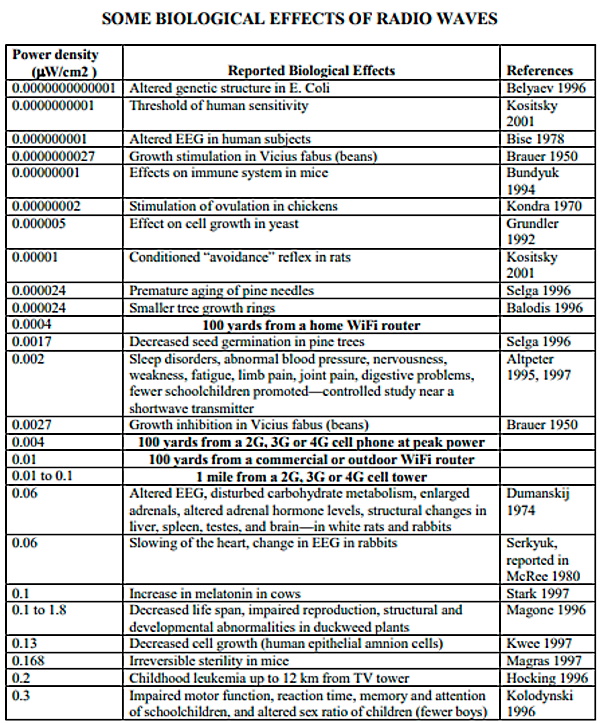
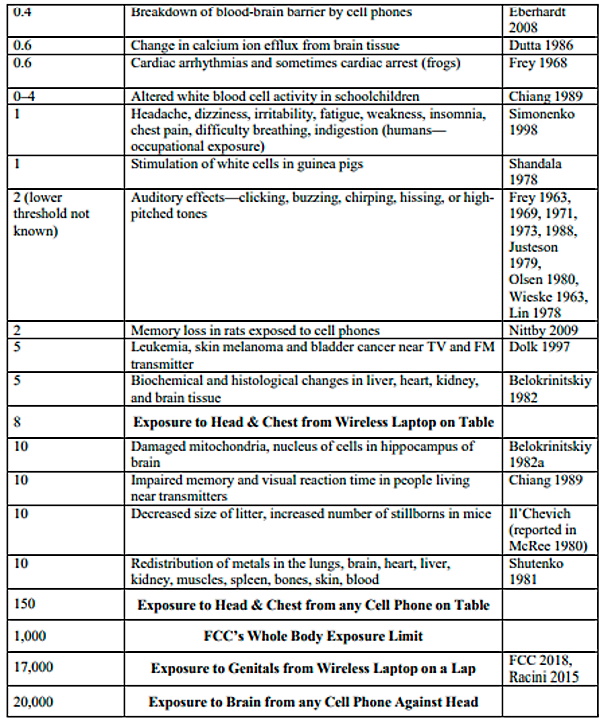
Morbidity and Mortality From Cell Phones and Wireless Technology
I. FLORA AND FAUNA
Aspens
In a backyard laboratory in the foothills of the Rocky Mountains, where trembling aspens were declining and refusing to display their colors in the fall, Katie Haggerty decided to find out what would happen if she shielded some of them from radio waves. After just two months, her shielded seedlings were 74 percent longer, and their leaves 60 percent larger than either her unshielded seedlings or her mock-shielded seedlings. And in the fall, only her shielded seedlings displayed the bright colors for which aspens are famous. (Haggerty 2010)
Songbirds
At Germany’s University of Oldenburg, scientists who were shocked to find that the migratory songbirds they were studying were no longer able to orient toward the north in spring and toward the southwest in autumn, decided to find out what would happen if they shielded an aviary from radio waves. Suddenly the birds were able face north in spring for migration. (Engels et al. 2014)
Amphibians
On a fifth floor apartment’s terrace in Barcelona, a block away from a cell tower, Alfonso Balmori decided to test his conjecture that radio waves might be responsible for the worldwide decline and extinction of so many species of amphibians. For two months he cared for two identical tanks of tadpoles, one of which was shielded from radio waves by a thin layer of fabric. The mortality in the unshielded tank was 90%, and in the shielded tank only 4%. (Balmori 2006)
Honey Bees
A professor at Panjab University in India decided to test her conjecture that wireless technology might be responsible for colony collapse disorder in honey bees. She put cell phones in two of four hives and turned them on twice a day for 15 minutes at a time. After three months there was neither honey, nor pollen, nor brood, nor bees in the two colonies with cell phones. (Sharma and Kumar 2010)
She then decided to find out what was happening in the bees’ hemolymph, which is what their blood is called. And she found that cellular respiration was brought almost to a standstill. After just ten minutes of exposure to a cell phone, the bees practically could not metabolize sugars, fats, or proteins. (Kumar et al. 2011)
Mice
In the Greek village of Chortiatis, on the third floor of the Public Primary School, six pairs of mice were mated and observed through five pregnancies. The first three pregnancies produced an average of five offspring per female. After that all the mice were sterile, giving birth to no more offspring. Visible from the schoolroom window, about one mile away, was an antenna farm atop Chortiatis Mountain, broadcasting, in total, about 300 kW of power.
Six more pairs of mice were bred in a wildlife preserve, Refuge of Hypaithrios Life, located on the mountain. These mice averaged only one newborn per pregnancy from the beginning, and were sterile by the third pregnancy. The sterility was proven to be permanent and irreversible. (Magras and Xenos 1997)
Ants
Marie-Claire Cammaerts, at the Free University of Belgium, brought thousands of ants into her laboratory, placed an older model flip phone under their colonies and watched them walk. When the phone contained no battery it affected them not at all. Nor did the battery alone. But as soon as the battery was placed in the phone—even though the phone was still turned off—the ants darted back and forth with vigor, as if trying to escape an enemy they could not see. When she put the phone into standby mode, the ants’ frenzy increased even more. When she finally turned the phone on, they all slowed down.
Cammaerts next exposed a fresh ant colony to a smartphone and then a cordless phone. In each case their rate of changing directions doubled or tripled within one or two seconds while their actual walking speed drastically slowed. After they were exposed for three minutes, they required two to four hours before they appeared normal again. Other ants, after being exposed to a WiFi router for thirty minutes, took six to eight hours to recover, and some were found dead a few days later. When she placed a flip phone in standby mode under the ants’ nest instead instead of their foraging area, the ants all immediately left their nest, taking their eggs, larvae, and nymphs with them. (Cammaerts and Johansson 2014)
Rats
Neurosurgeon Leif Salford’s team at the University of Lund in Sweden exposed rats to an ordinary cell phone, just once for two hours, and sacrificed them 50 days later. The exposed rats had permanent brain damage from that single exposure—even when the power level of the phone was reduced a hundredfold. (Salford et al. 2003)
Cows
When cell towers were raised all across America in 1996, reports came in from farmers of farm animals suddenly sick and dying, and their offspring born with webbed necks and legs on backwards. (Hawk 1996). Wolfgang Löscher and Günter Käs, receiving similar reports in Germany, visited such farms and examined such cows. Cows were dying from acute heart and circulatory collapse with bleeding from several organs. When sick cows were removed to a distant location they recovered their health. (Löscher and Käs 1998)
Fruit Flies
For a science fair experiment, fifteen-year-old Alexander Chan, at Benjamin Cardozo High School in Queens, New York exposed fruit fly larvae daily to a loudspeaker, a computer monitor, or a cell phone and observe their development. The flies that were exposed to the cell phone failed to develop wings. (Serant 2004)
Cress Seeds
For another science fair experiment, a team of five ninth grade girls in Hjallerup, Denmark filled twelve trays with 400 cress seeds each. They placed six trays in a window next to three laptop computers and two WiFi routers, and six trays in a similar window but without computers or routers. After 6 days, none of the irradiated seeds had sprouted, and many of them never did.
After 12 days, the control sprouts were twice as large as those next to the laptops and routers. (Nielsen et al. 2013)
Pepper Plants
Scientists at the University of Gaza grew 100 pepper seedlings under identical conditions, except that half of them were watered daily with tap water that had sat in a glass flask for one hour next to a WiFi router, and the other half with tap water that had sat in an identical glass flask but not next to a router. The plants grown with irradiated water were pale and stunted. After 200 days, the control plants were 25% longer, their stems 5% thicker, and their roots 40% longer than the plants grown with irradiated water. They also weighed 90% more, had 74% more leaves, were 12% more moist, flowered and fruited earlier, and produced 38% larger fruit. (Alattar and Radwan 2020)
Radio Collared Animals
Radio collared mammals, including rabbits, voles, lemmings, badgers, foxes, deer, moose, armadillos, river otters, and sea otters have suffered increased mortality, impaired digging ability, weight loss, reduced activity levels, increased self-grooming, altered social interactions, and reproductive failure. (Mech and Barber 2002)
In a study of moose, calves without any ear tags and calves with plain ear tags had 10% mortality, while calves with ear tags that contained transmitters had 68% mortality. The only difference was the radio waves. (Swenson et al. 1999)
In another study, water vole colonies that contained radio-tagged females gave birth to four times as many males as females. The researchers concluded that likely none of the radio-tagged female voles gave birth to any female offspring. (Moorhouse and Macdonald 2005)
II. HUMANS
Radio Wave Sickness
During the 1950s clinics were established in Moscow, Leningrad, and other cities in the Soviet Union and Eastern Europe to study and treat thousands of workers suffering from a new occupational disease—a disease which was also reported in the United States but which was neither studied nor treated there. The new disease was named radio wave sickness. These patients manufactured, inspected, repaired or operated microwave equipment. Some worked at radar facilities, others for radio or TV stations, or telephone companies. Still others operated radio frequency heaters and sealers being used in an expanding number of industries using technology developed during World War II.
These workers were exposed to microwave radiation only during working hours. And they were exposed to levels of radiation that were less than what the general public is exposed to now for hours per day, or even all the time, from their cell phones and other wireless devices.
The patients at these clinics suffered from headaches, fatigue, weakness, sleep disturbance, irritability, dizziness, memory difficulty, sexual dysfunction, skin rash, hair loss, decreased appetite, indigestion, and occasionally sensitivity to sunlight. Some had heart palpitations, stabbing pains in the region of the heart, and shortness of breath after exertion. Many developed emotional instability, anxiety or depression, and a few had mania or paranoia.
On physical exam they had acrocyanosis (blue fingers and toes), impaired sense of smell, sweating, tremors, altered reflexes, unequal pupil size, heart arrhythmias, and unstable pulse and blood pressure. They had abnormal EEGs and EKGs and, in advanced stages, signs of oxygen deprivation to the heart and brain. Some developed cataracts. Blood work showed hyperactive thyroid, elevated histamine, elevated blood sugar, elevated cholesterol and triglycerides, an increase in blood proteins, a decrease in the albumin-globulin ratio, decreased platelets and red blood cells, and abnormally high or low white blood cell count.
Although only about 15% of microwave workers complained of their illness, and only 2% ceased working (Sadchikova 1960, Klimková-Deutschová 1974), laboratory work revealed abnormalities in the majority of workers. Blood cholesterol was elevated in 40% of microwave workers (Klimkova-Deutschova 1974), triglycerides were elevated in 63% (Sadchikova et al. 1980), fasting blood sugar was increased in 74% (Klimkova-Deutschova 1974), and 70% had abnormal thyroid activity. (Smirnova and Sadchikova 1960; Drogichina 1960). Objective cardiac changes were found in 18% to 35% of microwave workers, depending on the length of time worked.
Because of the large number of publications about radio wave sickness coming out of the Soviet Union and Eastern Europe, a US/USSR scientific exchange on microwave radiation research was begun in the mid-1970s. And the US government commissioned Dr. Zorach Glaser to catalogue the world’s scientific literature—journal articles, books, conference proceedings—on reported biological and health effects of radio frequency and microwave radiation. By the end of the 1970s, Glaser’s bibliography included 5,083 documents (Glaser 1984).
During the 1960s and 1970s, ophthalmologist Milton Zaret, under contract with the US Army and US Air Force, examined the eyes of thousands of military and civilian personnel working at radar installations in the US and Greenland. Large numbers of them, he found, were developing cataracts. Most of these cataracts were caused by chronic exposure of the eye to radiation at power densities around one milliwatt per square centimeter—a level which is regularly exceeded by each of the 15 billion cell phones in use today (Birenbaum et al. 1969; Zaret 1973).
During those years American biologist Allan Frey discovered that microwave radiation damages the blood-brain barrier (Frey et al. 1975), and he proved that humans and animals can hear microwaves (Frey 1961). One of the most active American researchers during the 1960s and 1970s, Frey caused rats to become docile by irradiating them at a power density of 50 microwatts per square centimeter (Frey and Spector 1976). He altered specific behaviors at 8 microwatts per square centimeter (Frey and Wesler 1979). He altered the heart rate of live frogs at 3 microwatts per square centimeter (Frey and Eichert 1986). At only 0.6 microwatts per square centimeter, 15 times less than levels commonly encountered today at a normal operating distance from a wireless laptop, he caused frogs’ hearts to develop arrhythmias, and sometimes caused the hearts to stop beating, by timing the microwave pulses at a precise point during the heart’s rhythm (Frey and Seifert 1968). Frey’s work was funded by the US Navy.
In 1977 Paul Brodeur, in his book, The Zapping of America, warned that proliferating microwave towers and radar facilities were endangering public health. But compared to today, microwave and radio facilities were still very rare indeed.
When in 1977 Apple sold its first (wired) personal computers, exposure to high levels of electromagnetic radiation spread to the general population, and electromagnetic illness ceased being only an occupational disease. In that year deaths from asthma in the US, which had been declining steadily for decades, began to rise for the first time.
In 1981, Representative Al Gore chaired the first of a number of US Congressional hearings on the health effects of (wired) video display terminals (VDTs). These were held because two editors at The New York Times, young men in their 20s and 30s, had developed cataracts; half of all surveyed UPI and AP employees were complaining of visual problems or headaches; an unusual number of babies with birth defects had been born to employees at The Toronto Star; and clusters of miscarriages were occurring among female VDT operators all over the US and Canada.
The newspaper industry had been the earliest industry to be transformed by computer technol- ogy. During the 1981 hearings by the House Committee on Science and Technology, Charles A. Perlik, Jr., president of the Newspaper Guild, testified that had his membership known that VDTs were capable of dangerous emissions, “We would not have quietly permitted the transformation of an essentially benign workplace into a hazardous one.” In 1985 Canadian author Bob DeMatteo published a popular book titled Terminal Shock: The Health Hazards of Video Display Terminals.
In the mid-1980s Olle Johansson, a neuroscientist at the Karolinska Institute in Stockholm, discovered a new skin disease. Since only people who worked in front of computer screens got it, he named it screen dermatitis. Such patients often complained also of neurological symptoms such as memory loss, fatigue, insomnia, dizziness, nausea, headache and heart palpitations—the same neurological symptoms written about three decades earlier by Soviet doctors—but since Johansson’s specialty was skin diseases, he studied the skin of computer operators. His subjects ranged from those with only redness and itching, to those with severe, disfiguring skin lesions.
In the mid-1990s the telecommunications industry embarked on a project that was to result in the exposure of the entire world to microwave radiation on a previously unimagined scale. They planned to place a cell phone and a wireless computer in the hands of every man, woman and child on Earth—and to dot our world with so many broadcast antennas that those phones and computers would work in every home and every office, on every street, in every country, on the highest mountain and in the deepest valley, on every lake, and in every national park, wilderness area and wildlife refuge, without exception. And so during the next decades every human being has become a source of microwave radiation wherever he or she goes. And ambient levels of radiation have increased a thousandfold or more, everywhere on Earth.
Researchers began correlating symptoms such as sleep disturbance, fatigue, memory loss, headaches, depression, dizziness and tremors—the same symptoms reported to both Soviet and American doctors half a century previously—with both cell phone use and proximity to communication towers. By 2007, teams of scientists in 14 countries concluded that the health of as much as three quarters of the population of the Earth was significantly affected by wireless technology (Haugsdal 1998, Hocking 1998, Cao 2000, Oftedahl 2000, Chia 2000, Sandström 2001, Santini 2002, Navarro 2003, Santini 2003, Zwamborn 2003, Wilén 2003, Oberfeld 2004, Bortkiewicz 2004, Al-Khlaiwi 2004, Salama 2004, Meo 2005, Preece 2005, Waldmann-Selsam 2005, Szykjowska 2005, Balikci 2005, Balik 2005, Hutter 2006, Abdel-Rassoul 2007).
Other scientists have reported that cell phones cause eczema (Kimata 2002), blindness (Ye et al. 2001), childhood asthma (Li et al. 2001), Alzheimer’s disease (Salford et al. 2003, Şahin et al. 2015), deafness (Oktay and Dasdag 2006, Panda et al. 2011, Velayutham et al. 2014, Mishra 2010, Mishra 2011), and multiple sclerosis (İkinci et al. 2015).
The term “electromagnetic hypersensitivity” (“EHS”) was invented because no health authority in any Western country admits that electromagnetic radiation has any effect on the health of any normal person. EHS, therefore, refers to those people who have happened accidentally to find out what is making them sick, and who have bought into the fiction that they are abnormal and different from everyone else.
Signs and Symptoms
Neurological: headaches, dizziness, nausea, difficulty concentrating, memory loss, irritability, depression, anxiety, insomnia, fatigue, weakness, tremors, muscle spasms, numbness, tingling, altered reflexes, muscle and joint pain, leg/foot pain, “flu-like” symptoms, fever. More severe effects include seizures, paralysis, psychosis and stroke.
Cardiac: palpitations, arrhythmias, pain or pressure in the chest, low or high blood pressure, slow or fast heart rate, shortness of breath, and heart attacks.
Respiratory: sinusitis, bronchitis, asthma, and pneumonia.
Dermatological: skin rash, extreme sensitivity to touch, itching, burning, facial flushing.
Ophthalmologic: pain or burning in the eyes, pressure in or behind the eyes, deteriorating vision, floaters, cataracts.
Auditory: Chirping, buzzing, ringing in the ears, and hearing loss.
Reproductive: Decreased sperm count and motility; abnormal menstruation; infertility; miscarriage; birth defects.
Hematological: Anemia, elevated blood sugar, low platelets, low or high white cells, elevated cholesterol.
Other: digestive problems; abdominal pain; sweating; enlarged thyroid; adrenal exhaustion; testicular/ovarian pain; sexual dysfunction; dryness of lips, tongue, mouth, eyes; puffy lips; swollen throat; great thirst; dehydration; frequent urination; nosebleeds; internal bleeding; immune system abnormalities; redistribution of metals within the body; hair loss; brittle fingernails; pain in the teeth; deteriorating fillings; impaired sense of smell; light sensitivity.
Impaired Metabolism and Resulting Obesity, Diabetes, Heart Disease and Cancer
Radio waves interfere with electron transport in the mitochondria of every cell. This starves the cells of oxygen and impairs their ability to metabolize sugars, fats, and proteins, just like Kumar et al. (2011) demonstrated in honey bees (see above). The result is the modern pandemics of obesity, diabetes, heart disease, and cancer. These diseases are also aspects of radio wave sickness. See Arthur Firstenberg’s The Invisible Rainbow: A History of Electricity and Life, chapters 11, 12 and 13.
Power Level Is Irrelevant
As the chart at the beginning of this document shows, exposure levels are irrelevant where it concerns radio waves. Biological effects are found at 10 W/cm2, at 0.01 W/cm2, at 0.00001 W/cm2, at 0.00000001 W/cm2, and at 0.0000000000001 W/cm2.
As Allan Frey wrote, living organisms use electromagnetic fields (EMFs) for everything from cellular communication to nervous system function. “Electromagnetic fields are not a foreign substance to living beings like lead or cyanide. With foreign substances, the greater the dose, the greater the effect—a dose-response relationship.” Instead, he said, a living being is like a radio receiver. “The EMF signal the radio detects and transduces into the sound of music is almost immeasurably weak.” Similarly, even an immeasurably weak radio signal can interfere with biological functions. (Frey 1990, 1993)
Dr. Ross Adey, at Loma Linda University School of Medicine, wrote that our cells “whisper” to each other with electromagnetic signals. He said that EMFs act at the atomic level and that “a threshold might not exist” for the effects of radio waves. (Adey 1993)
Biophysicist Neil Cherry, at Lincoln University in New Zealand, wrote that radio signals “can interfere with hearts, brains and cells at extremely low intensities, approaching zero exposure” (Cherry 2000). He later presented “conclusive evidence” that “the safe level of exposure is zero.” (Cherry 2001)
For some effects, there is even an inverse dose-response, i.e. the lower the exposure level, the greater the harm. In other words, the more the external signal approaches the infinitesimal strength of our bodies’ own internal signals, the more it is recognized by the body, and the more it interferes with life.
Thus, Leif Salford’s team at Lund University found that the greatest damage to the blood-brain barrier occurred at the lowest dose of radiation (reduced ten thousand-fold), not the highest dose. (Persson 1997).
Numerous researchers, including Carl Blackman at the US Environmental Protection Agency, have found that microwave radiation causes calcium to flow out of brain cells. For this effect, these researchers have found power windows of maximal effect, i.e. the effect decreases at both lower and higher levels (Blackman 1980, 1986; Bawin 1977; Dutta 1986; Kunjilwar and Behari 1993). And it is the lowest power windows, not the highest, that have the greatest effect: the effect at an SAR of 0.0007 W/kg was quadruple the effect at an SAR of 2.0 W/kg (Dutta 1986).
Maria Sadchikova and her Soviet colleagues consistently reported in the 1960s and 1970s that among people occupationally exposed to microwave radiation, the sickest were those exposed to the lowest, not the highest levels. (Sadchikova 1960, 1974).
Igor Belyaev, at Stockholm University, found a genetic effect that occurred at specific frequencies. The magnitude of the effect did not change with power level over 14 orders of magnitude, all the way down to 0.00000000001 microwatts per square centimeter. (Belyaev 1996)
Nikolai Kositksy and his colleagues in Kiev, Ukraine reiterated that external radio signals interfere with our bodies’ own internal signaling, and that it is the informational content of radio waves, and not their power level, that causes harm. They reviewed 40 years of research in the Soviet Union and concluded: “Biological effects associated with these interactions depend not on the strength of the energy carried into one or another system, but on the information carried into it.” (Kositsky 2001)
Thus most of the effects of radio waves on our bodies are caused not by their power levels but by their frequencies, bandwidths, pulsations, waveforms, and all the other attributes that enable them to carry information and make them useful to cell phones and computers. It is the coherent nature of the radiation and the information that it carries that kills. And therefore light (LiFi) and any other carrier of the same information is just as harmful, as are lasers. A laser is coherent light.
We evolved without microwaves and without coherent radiation. The microwave radiation from the Sun is not coherent, is not centered at any particular frequency, varies in total from .0000001 W/cm2 to .0001 W/cm2 when the Sun is most active, and we are only exposed to it during the day; at night, only the far weaker microwaves from the stars reach Earth.
Living beings should not ever contact, or be near, any source of coherent radiation, or any source of microwave radiation. Not WiFi, not Bluetooth, not baby monitors, not microwave ovens, and not cell phones. Not even for a few seconds. Cell phones, because of their ubiquity and their proximity to the body, are causing by far the most harm to health, society, and planet.
Number of People With: Headache disorders: 4 billion (Stovner 2022)
Chronic pain: 2 billion (Antunes 2021)
Brain diseases: 1.3 billion (American Brain Foundation 2022)
REFERENCES
Abdel-Rassoul, G. et al. 2007. Neurobehavioral effects among inhabitants around mobile phone base stations. NeuroToxicology 28(2): 434-40.
Adey, W. R. 1993. Whispering between cells: Electromagnetic fields and regulatory mechanisms in tissue. Frontier Perspectives 3(2):21-25.
Al-Khlaiwi, T. and S. A. Meo 2004. Association of mobile phone radiation with fatigue, headache, dizziness, tension and sleep disturbance in Saudi population. Saudi Medical Journal 25(6): 732-736.
Alattar, E. and E. Radwan 2020. Investigation of the effects of radio frequency water treatment on some characteristics of growth in pepper (Capsicum annuum) plants. Advances in Bioscience and Technology 11:22-48.
Altpeter, E.-S. et al. 1995. Study on health effects of the shortwave transmitter station of Schwarzenburg, Berne, Switzerland. Study No. 55, Swiss Federal Office of Energy.
Altpeter, E.-S. et al. 1997. Do radiofrequency electromagnetic fields cause sleep disorders? European Regional Meeting of the International Epidemiological Association, Münster, Germany, September. Abstract no. 351.
American Brain Foundation 2022. Brain Diseases from A to Z. https://www.americanbrainfoundation.org/diseases/
Antunes, F. et al. 2021. Prevalence and characteristics of chronic pain among patients in Portuguese primary care units. Pain and Therapy 10:1427-1437.
Balik, H. H. et al. 2005. Some ocular symptoms and sensations experienced by long term users of mobile phones. Pathologie Biologie 53(2): 88-91.
Balikci K. et al. 2005. A survey study on some neurological symptoms and sensations experienced by long term users of mobile phones. Pathologie Biologie 53(1): 30-34.
Balmori, A. 2006. The incidence of electromagnetic pollution on the amphibian decline: Is this an important piece of the puzzle? Toxicological and Environmental Chemistry 88(2):287-89.
Balodis, V. et al. 1996. Does the Skrunda Radio Location Station diminish the radial growth of pine trees? The Science of the Total Environment 180:81-85.
Bawin, S. M., A. Sheppard and W. R. Adey 1977. Possible mechanisms of weak electromagnetic field coupling in brain tissue. In The Physical Basis of Electromagnetic Interactions with Biological Systems, Proceedings of a Workshop Held at the University of Maryland, College Park, Maryland, June 15-17, 1977, pp. 75-90.
Belokrinitskiy, V. S. 1982. Hygienic evaluation of biological effects of nonionizing microwaves.
Gigiyena i Sanitariya 6:32-34, JPRS 81865, pp. 1-5.
Belokrinitskiy, V. S. 1982a. Destructive and reparative processes in hippocampus with long-term exposure to nonionizing microwave radiation. Bulletin of Experimental Biology and Medicine 93(3):89-92.
Belyaev, I. Y. et al. 1996. Resonance effect of millimeter waves in the power range from 10–19 to 3 x 10–3 W/cm2 on Escherichia coli cells at different concentrations. Bioelectromagnetics
17:312-321.
Birenbaum, L. et al. 1969. Effect of microwaves on the eye. IEEE Transactions on Biomedical Engineering 16(1):7-14.
Bise, W. 1978. Low power radio-frequency and microwave effects on human electroencephalogram and behavior. Physiological Chemistry and Physics 10(5):387-398.
Blackman, C. F. et al. 1980. Induction of calcium-ion efflux from brain tissue by radiofrequency radiation. Bioelectromagnetics 1:35-43.
Blackman, C. 1986. Radiobiological approaches to electropollution. In Biological Effects of Electropollution, S. Dutta and R. Millis, eds., Information Ventures, Phila., pp. 39-46.
Bortkiewicz, A. et al. 2004. Subjective symptoms reported by people living in the vicinity of cellular phone base stations. Medycyna Pracy 55(4): 345-351, in Polish.
Brauer, I. 1950. Experimenta1 studies on the effect of meter waves of various field intensities on the growth of plants by division. Chromosoma 3:483-509.
Brodeur, P. 1977. The Zapping of America. NY: W.W. Norton.
Bundyuk, L. S. et al. 1994. Corrective action of millimeter waves on systems of various levels of hierarchy. Physics of the Alive 2(1):12-25.
Cammaerts, M.-C. and O. Johansson 2014. Ants can be used as bio-indicators to reveal biological effects of electromagnetic waves from some wireless apparatus.” Electromagnetic Biology and Medicine 33(4):282-88.
Cao Z. et al. 2000. Effects of electromagnetic radiation from cellular telephone handsets on symptoms of neurasthenia. Wei Sheng Yan Jiu 29(6): 366-368, in Chinese.
Cherry, N. 2000. Safe Exposure Levels. Lincoln University, April 25, 2000.
Cherry, N. 2001. Evidence of brain cancer from occupational exposure to pulsed microwaves from a police radar. Lincoln University, August 15, 2001.
Chia, S.-I. et al. 2000. Prevalence of headache among hand-held cellular telephone users in Singapore: a community study. Environmental Health Perspectives 108(11): 1059-1062.
Chiang, H. et al. 1989. Health effects of environmental electromagnetic fields. Journal of Bioelectricity 8(1):127-131.
DeMatteo, B. 1985. Terminal Shock: The Health Hazards of Video Display Terminals. Toronto: NC Press.
Dolk, H. et al. 1997. Cancer incidence near radio and television transmitters in Great Britain, I. Sutton Coldfield transmitter. American Journal of Epidemiology 145(1):1-9.
Drogichina, E. A. 1960. The clinic of chronic UHF influence on the human organism. In The Biological Action of Ultrahigh Frequencies, A. A. Letavet and Z. V. Gordon, eds., Academy of Medical Sciences, Moscow. JPRS 12471, pp. 22-24.
Dumanskij, J. D., and M. G. Shandala 1974. The biologic action and hygienic significance of electromagnetic fields of super-high and ultrahigh frequencies in densely populated areas. In Biologic Effects and Health Hazards of Microwave Radiation, Proceedings of an International Symposium, Warsaw, 15-18 October 1973, P. Czerski et al., eds, pp. 289-293.
Dutta, S. K. et al. 1986. Microwave radiation-induced calcium ion flux from human neuroblastoma cells: dependence on depth of amplitude modulation and exposure time. In Biological Effects of Electropollution, S. K. Dutta and R. M. Millis, eds., pp. 63-69.
Philadelphia, PA: Information Ventures.
Eberhardt, J. L. et al. 2008. Blood-brain barrier permeability and nerve cell damage in rat brain 14 and 28 days after exposure to microwaves from GSM mobile phones. Electromagnetic Biology and Medicine 27:215-229.
Engels, S. et al. 2014. Anthropogenic electromagnetic noise disrupts magnetic compass orientation in a migratory bird. Nature 509:353-56.
Federal Communications Commission 2018. FCC SAR Test Report. Report No. SA180725W003-1. August 14, 2018.
Firstenberg, A. 1997. Microwaving Our Planet: The Environmental Impact of the Wireless Revolution. NY: Cellular Phone Task Force.
Firstenberg, A. 2020. The Invisible Rainbow: A History of Electricity and Life. White River Junction, VT: Chelsea Green.
Frey, A. H. 1961. Auditory system response to radio frequency energy. Aerospace Medicine 32: 1140-1142.
Frey, A. H. 1963. Human response to very-low-frequency electromagnetic energy. Nav. Res. Rev. 1968:1-4.
Frey, A. H., and E. Seifert 1968. Pulse modulated UHF energy illumination of the heart associated with change in heart rate. Life Sciences 7(Part II):505-512.
Frey, A. H. 1970. Effects of microwave and radio frequency energy on the central nervous system. In Biological Effects and Health Implications of Microwave Radiation, Symposium Proceedings, Richmond, Virginia, September 17-19, 1969, S. F. Cleary, ed., pp. 134-139.
Frey, A. H. 1971. Biological function as influenced by low power modulated RF energy. IEEE Transactions on Microwave Theory and Techniques, MTT-19(2):153-164.
Frey, A. H., and R. Messenger 1973. Human perception of illumination with pulsed ultrahigh- frequency electromagnetic energy. Science 181:356-358.
Frey, A. H. et al. 1975. Neural function and behavior: defining the relationship. Annals of the New York Academy of Sciences 247:433-439.
Frey, A. H. and J. Spector 1976. Irritability and aggression in mammals as affected by exposure to electromagnetic energy. Proceedings of the 1976 Annual Meeting of the International Union of Radio Science, October 15-19, 1976, Amherst, Mass., p. 93.
Frey, A. H. and L. Wesler 1979. Modification of tail pinch consummatory behavior in microwave energy exposure. In Program and Abstracts, National Radio Science Meeting, June 18-22, 1979, Seattle, Washington, p. 456.
Frey, A. H. and E. S. Eichert 1986. “Modification of Heart Function with Low Intensity Electromagnetic Energy.” Electromagnetic Biology and Medicine 5(2):201-210.
Frey, A. H. 1988. Evolution and results of biological research with low-intensity nonionizing radiation. In Modern Bioelectricity, A. A. Marino, ed., pp. 785-837. New York, NY: Dekker.
Frey, A. H. 1990. Is a toxicology model appropriate as a guide for biological research with electromagnetic fields? Journal of Bioelectricity 9(2):233-234.
Frey, A. H. 1993. On the nature of electromagnetic field interactions with biological systems.
FASEB Journal 7(2):272-281.
Glaser, Z. 1984. Cumulated index to the Bibliography of reported biological phenomena
(“effects”) and clinical manifestations attributed to microwave and radio-frequency radiation: report, supplements (no. 1-9), BEMS newsletter (B-1 through B-464), 1971-1981. Indexed by Julie Moore. Riverside, CA: Julie Moore & Associates.
Grundler, W. and F. Kaiser 1992. Experimental evidence for coherent excitations correlated with cell growth. Nanobiology 1:163-176.
Haggerty, K. 2010. Adverse influence of radio frequency background on trembling aspen seedlings: Preliminary observations. International Journal of Forestry Research, article ID 836278.
Haugsdal, B. et al. 1998. Comparison of symptoms experienced by users of analogue and digital mobile phones: a Swedish-Norwegian epidemiological study. Arbetslivsrapport 23, National Institute for Working Life, Umeå, Sweden.
Hawk, K. 1996. Case Study in the Heartland. Butler, PA.
Hocking, B. and I. Gordon 1996. Cancer incidence and mortality and proximity to TV towers.
Medical Journal of Australia 165(11-12):601-605.
Hocking, B. 1998. Symptoms associated with mobile phone use. Occupationa1 Medicine
48(6):357-360, and letter, vol. 48(7):472.
Hutter, H.-P. et al. 2006. Subjective symptoms, sleeping problems, and cognitive performance in subjects living near mobile phone base stations. Occupational and Environmental Medicine 63:307–13.
İkinci, A. et al. 2013. The effects of prenatal exposure to a 900 megahertz electromagnetic field on hippocampus morphology and learning behavior in rat pups. Journal of Experimental and Clinical Medicine 30:278. Abstract.
Justeson, D. R. 1979. Behavioral and psychological effects of microwave radiation. Bulletin of the New York Academy of Medicine 55(11):1058-1078.
Kimata, H. 2002. Enhancement of allergic skin wheal responses by microwave radiation from mobile phones in patients with atopic eczema/dermatitis syndrome. International Archives of Allergy and Immunology 129(4):348-50.
Klimkova-Deutschova, E. 1974. Neurologic findings in persons exposed to microwaves. In Biologic Effects and Health Hazards of Microwave Radiation, Proceedings of an International Symposium, Warsaw, 15-18 October 1973, P. Czerski et al., eds., pp. 268-272.
Kolodynski, A. A. and V. V. Kolodynska 1996. Motor and psychological functions of school children living in the area of the Skrunda Radio Location Station in Latvia. The Science of the Total Environment 180:87-93.
Kondra, P. A. et al. 1970. Growth and reproduction of chickens subjected to microwave radiation. Canadian Journal of Animal Science 50:639-644.
Kositsky, N. N. et al. 2001. Influence of high-frequency electromagnetic radiation at non-thermal intensities on the human body (a review of work by Russian and Ukrainian researchers). No Place To Hide 3(1) Supplement.
Kumar, N. R. et al. 2011. Exposure to cell phone radiations produces biochemical changes in worker honey bees. Toxicology International 18(1):70-72.
Kunjilwar, K. K. and J. Behari 1993. Effect of amplitude-modulated RF radiation on cholinergic system of developing rats. Brain Research 601:321-324.
Kwee, S. and P. Raskmark 1997. Radiofrequency electromagnetic fields and cell proliferation. In Proceedings of the Second World Congress for Electricity and Magnetism in Biology and Medicine, June 8-12, 1997, Bologna, Italy, F. Bersani, ed.
Li, D.-K. et al. 2011. Maternal exposure to magnetic fields during pregnancy in relation to the risk of asthma in offspring. Archives of Pediatrics & Adolescent Medicine 16(10):945-50.
Lilienfeld, A. M. 1978. Evaluation of Health Status of Foreign Service and Other Employees from Selected Eastern European Posts. National Technical Information Service, PB288-163.
Lin, J. C., 1978. Microwave Auditory Effects and Applications. Springfield, IL: Charles C. Thomas.
Löscher, W. and G. Käs 1998. Auffällige Verhaltensstörungen bei Rindern im Bereich von Sendeanlagen. Der praktische Tierarzt 79(5):437-444.
Magone, I., 1996. The effect of electromagnetic radiation from the Skrunda Radio Location Station on Spirodela polyrhiza (L.) Schleiden cultures. The Science of the Total Environment 180:75-80.
Magras, I. N. and T. D. Xenos 1997. RF radiation-induced changes in the prenatal development of mice. Bioelectromagnetics 18:455-461.
McRee, D. I. 1980. Soviet and Eastern European research on biological effects of microwave radiation. Proceedings of the IEEE 68(1):84-91.
Mech, L. D. and S. M. Barber 2002. A Critique of Wildlife Radio-Tracking and Its Use in National Parks. Jamestown, ND: U.S. Geological Survey, Northern Prairie Wildlife Research Center.
Meo, S. A. and A. M. Al-Drees 2005. Mobile phone related-hazards and subjective hearing and vision symptoms in the Saudi population. International Jouranl of Occupational Medicine and Environmental Health 18(1):53-57.
Mishra, L. 2011. Heard this? Talking on the phone makes you deaf. Mumbai Mirror, October 26.
Mishra, S. K. 2010. Otoacoustic emission (OAE)-based measurement of the functioning of the human cochlea and the efferent auditory system. Ph.D. thesis, University of Southampton.
Moorhouse, T. P. and D. W. Macdonald 2005. Indirect negative impacts of radio-collaring: Sex ratio variation in water voles. Journal of Applied Ecology 42:91-98.
Navarro, A. E. et al. 2003. The microwave syndrome: A preliminary study in Spain.
Electromagnetic Biology and Medicine 22(2):161–169.
Nielsen, L. et al. 2013. Undersøgelse af non-termiske effecter af mobilstråling. 9.B Hjallerup skole 28-02-2013.
Nittby, H. et al. 2008. Cognitive impairment in rats after long-term exposure to GSM-900 mobile phone radiation. Bioelectromagnetics 29:219-232.
Oberfeld, G. et al. 2004. The microwave syndrome: further aspects of a Spanish study. In Proceedings of the 3rd International Workshop on Biological Effects of Electromagnetic Fields, 4-8 October, 2004, Kos, Greece.
Oftedal, G. et al. 2000. Symptoms experienced in connection with mobile phone use.
Occupational Medicine (London) 50:237-245.
Oktay, M. F. and S. Dasdag 2006. Effects of intensive and moderate cellular phone use on hearing function. Electromagnetic Biology and Medicine 25:13-21.
Olsen, R. G. 1980. Evidence for microwave-induced acoustic resonances in biological material.
Bioelectromagnetics 1:219.
Panda, N. K. et al. 2011. Auditory changes in mobile users: is evidence forthcoming?
Otolaryngology – Head and Neck Surgery 144(4):581-85.
Persson, B. R. R. et al. 1997. Blood-brain barrier permeability in rats exposed to electromagnetic fields used in wireless communication. Wireless Networks 3:455-461.
Perlik, C. 1981. Testimony in Potential Health Effects of Video Display Terminals and Radio Frequency Heaters and Sealers. Hearings before the Subcommittee on Investigations and Oversight of the Committee on Science and Technology, U.S. House of Representatives, Ninety- seventh Congress, first session, May 12, 13, 1981, p. 7.
Preece, A. W. et al. 2005. The Akrotiri Military Antennae Health Survey. Department of Medical Physics and Oncology, University of Bristol, Final Report, June 2, 2005.
Racini, S. M. et al. 2015. Simulation of psSAR associated with the use of laptop computers as a function of position in relation to the adult body. BioEM2015, June 14-19, 2015, Annual Meeting of the Bioelectromagnetics Society. Poster.
Sadchikova, M. N. 1960. State of the nervous system under the influence of UHF. In The Biological Action of Ultrahigh Frequencies, A. A. Letavet and Z. V. Gordon, eds., Academy of Medical Sciences, Moscow, pp. 25-29.
Sadchikova, M. N. 1974. Clinical manifestations of reactions to microwave irradiation in various occupational groups. In Biologic Effects and Health Hazards of Microwave Radiation: Proceedings of an International Symposium, Warsaw, 15-18 October, 1973, P. Czerski et al., eds., pp. 261-267.
Sadchikova, M. N. et al. 1980. Significance of blood lipid and electrolyte disturbances in the development of some reactions to microwaves. Gigiyena Truda i Professional’nyye Zabolevaniya, no. 2, 1980, pp. 38-39, JPRS 77393, pp. 37-39.
Salama, O. E. and R. M. Abou El Naga 2004. Cellular phones : Are they detrimental? Journal of the Egyptian Public Health Association 79(3-4):197-223.
Şahin, A. et al. 2015. Deleterious impacts of a 900-MHz electromagnetic field on hippocampal pyramidal neurons of 8-week-old Sprague Dawley male rats. Brain Research 1624:232-38.
Salford, L. G. et al. 2003. Nerve cell damage in mammalian brain after exposure to microwaves from GSM mobile phones. Environmental Health Perspectives 111(7):881-83.
Sandström, M. et al. 2001. Mobile phone use and subjective symptoms. Comparison of symptoms reported by users of analogue and digital mobile phones. Occupational Medicine (London) 51:25–35.
Santini, R. et al. 2002. Symptoms experienced by users of digital cellular phones: A study of a French engineering school. Electromagnetic Biology and Medicine 21:81-88.
Santini, R. et al. 2003. Survey study of people living in the vicinity of cellular phone base stations. Electromagnetic Biology and Medicine 22:41-49.
Selga, T. and M. Selga 1996. Response of Pinus sylvestris L. needles to electromagnetic fields. Cytological and ultrastructural aspects. The Science of the Total Environment 180:65-73.
Serant, C. 2004. A human science experiment. New York Newsday, May 10.
Shandala, M. G., and G. I. Vinogradov 1978. Immunological effects of microwave action.
Gigiyena I Sanitariya, no. 10, 1978, pp. 34-38, JPRS 72956, pp. 16-21.
Sharma, V. P. and N. R. Kumar 2010. Changes in honeybee behaviour and biology under the influence of cellphone radiations. Current Science 98(10):1376-78.
Shutenko, O. I. et al. 1981. Effects of superhigh frequency electromagnetic fields on animals of different ages. Gigiyena i Sanitariya, no. 10, 1981, pp. 35-38, JPRS 84221, pp. 85-90.
Simonenko, V. B. et al. 1998. Influence of electromagnetic radiation in the radiofrequency range on the health condition of an organized collective. Voenno-meditsinskiy zhurnal 319(5):64-68.
Smirnova, M. I. and M. N. Sadchikova 1960. Determination of the functional activity of the thyroid gland by means of radioactive iodine in works with UHF generators. In The Biological Action of Ultrahigh Frequencies, A. A. Letavet and Z. V. Gordon, eds., Academy of Medical Sciences, Moscow. JPRS 12471, pp. 47-49.
Stark, K. et al. 1997. Absence of chronic effect of exposure to short-wave radio broadcast signal on salivary melatonin concentrations in dairy cattle. Journal of Pineal Research 22:171-76.
Stovner, L. J. et al. 2022. The global prevalence of headache: an update, with analysis of the influences of methodological factors on prevalence estimates. The Journal of Headache and Pain 23, Article No 34.
Swenson, J. E. et al. 1999. Effects of ear-tagging with radiotransmitters on survival of moose calves. Journal of Wildlife Management 63(1):354-58.
Szyjkowska, A. et al. 2005. Subjective symptoms related to mobile phone use – a pilot study.
Polski Merkuriusz Lekarski 19(112):529-532, in Polish.
Velayutham, P. et al. 2014. High-frequency hearing loss among mobile phone users. Indian Journal of Otolaryngology and Head & Neck Surgery 66:S169-S172.
Waldmann-Selsam, C. 2005. The Bamberg Report. Bamberg, Germany.
Wieske, C. W. 1963. Human sensitivity to electric fields. In Proceedings of the First National Biomedical Sciences Instrumentation Symposium, Los Angeles, July 14-17, 1962.
Wilén J. et al. 2003. Subjective symptoms among mobile phone users – A consequence of absorption of radiofrequency fields? Bioelectromagnetics 24(3):152-59.
Ye, J. et al. 2001. Low power density microwave radiation induced early changes in rabbit lens epithelial cells. Chinese Medical Journal 114(12):1290-94.
Zaret, M. M. 1973. Microwave cataracts. Medical Trial Technique Quarterly 19(3):246-52.
Zwamborn, A. P. M. et al. 2003. Effects of Global Communications System Radiofrequency Fields on Well Being and Cognitive Functions of Human Subjects with and without Subjective Complaints. TNO report, FEL-03-C148. The Hague.
Connect with Arthur Firstenberg
cover image credit: hpgruesen / pixabay


